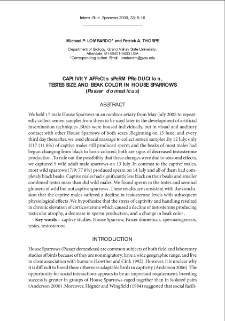Digital Library of Zielona Góra contains 63 482 digital objects
Object
Title: Captivity affects sperm production, testes size and beak color in House Sparrows ("Passer domesticus")
Group publication title:
Abstract:
We held 17 male House Sparrows in an outdoor aviary from May-July 2005 to repeatedly collect semen samples from them to be used later in the development of artificial insemination techniques. Birds were housed individually, but in visual and auditory contact with other House Sparrows of both sexes. ; Beginning on 15 June, and every third day thereafter, we used cloacal massage to collect semen samples. By 12 July, only 2/17 (11.8%) of captive males still produced sperm and the beaks of most males had begun changing from black to horn-colored; both are signs of decreased testosterone production. To rule out the possibility that these changes were due to seasonal effects, we captured 9 wild adult male sparrows on 13 July. ; In contrast to the captive males, most wild sparrows (7/9; 77.8%) produced sperm on 14 July and all of them had completely black beaks. Captive males had significantly less black on their beaks and smaller combined testes mass than did wild males. We found sperm in the testes and seminal glomera of wild but not captive sparrows. These results are consistent with the conclusion that the captive males suffered a decline in testosterone levels with subsequent physiological effects. ; We hypothesize that the stress of captivity and handling resulted in chronic elevation of corticosterone which caused a decline of testosterone producing testicular atrophy, a decrease in sperm production, and a change in beak color.
Publisher:
Zielona Góra: University of Zielona Góra, Faculty of Biological Sciences
Format:
Resource Identifier:
Pages:
Source:
International Studies on Sparrows, vol. 33
Language:
Rights:
Biblioteka Uniwersytetu Zielonogórskiego
Object collections:
- Digital Library of Zielona Góra > Repository > Faculties > Faculty of Biological Sciences
- Digital Library of Zielona Góra > Repository > Types of work > Articles
- Digital Library of Zielona Góra > Repository > Scientific journals and UZ publishing series > International Studies on Sparrows
Last modified:
May 23, 2023
In our library since:
May 4, 2023
Number of object content hits:
122
All available object's versions:
https://zbc.uz.zgora.pl/publication/81548
Show description in RDF format:
Show description in OAI-PMH format:
| Edition name | Date |
|---|---|
| Captivity affects sperm production, testes size and beak color in House Sparrows ("Passer domesticus") | May 23, 2023 |
Objects Similar
Lombardo, Michael P. Thorpe, Patrick A. Colpetzer, Sheila
Morawin, Barbara Asienkiewicz, Ryszard - red. Tatarczuk, Józef - red.

